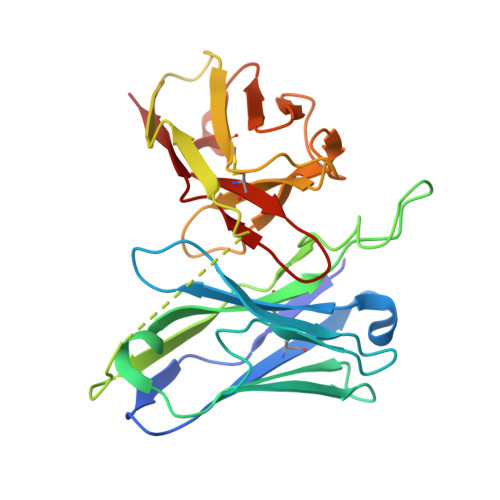Crystal structure of a 3B3 variant-A broadly neutralizing HIV-1 scFv antibody.
Clark, K.R., Walsh, S.T.(2009) Protein Sci 18: 2429-2441
- PubMed: 19785005
- DOI: https://doi.org/10.1002/pro.255
- Primary Citation of Related Structures:
3JUY - PubMed Abstract:
We present the crystal structure determination of an anti-HIV-1 gp120 single-chain variable fragment antibody variant, 3B3, at 2.5 A resolution. This 3B3 variant was derived from the b12 antibody, using phage display and site-directed mutagenesis of the variable heavy chain (V(H)) complementary-determining regions (CDRs). 3B3 exhibits enhanced binding affinity and neutralization activity against several cross-clade primary isolates of HIV-1 by interaction with the recessed CD4-binding site on the gp120 envelope protein. Comparison with the structures of the unbound and bound forms of b12, the 3B3 structure closely resembles these structures with minimal differences with two notable exceptions. First, there is a reorientation of the CDR-H3 of the V(H) domain where the primary sequences evolved from b12 to 3B3. The structural changes in CDR-H3 of 3B3, in light of the b12-gp120 complex structure, allow for positioning an additional Trp side chain in the binding interface with gp120. Finally, the second region of structural change involves two peptide bond flips in CDR-L3 of the variable light (V(L)) domain triggered by a point mutation in CDR-H3 of Q100eY resulting in changes in the intramolecular hydrogen bonding patterning between the V(L) and V(H) domains. Thus, the enhanced binding affinities and neutralization capabilities of 3B3 relative to b12 probably result from higher hydrophobic driving potential by burying more aromatic residues at the 3B3-gp120 interface and by indirect stabilization of intramolecular contacts of the core framework residues between the V(L) and V(H) domains possibly through more favorable entropic effect through the expulsion of water.
Organizational Affiliation:
Center for Gene Therapy, Nationwide Children's Hospital, Columbus, Ohio 43205, USA.














